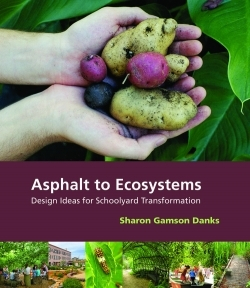Asphalt to Ecosystems
Design Ideas for Schoolyard Transformation
“One of the more dramatic shifts in modern childhood … is the loss of freedom,” laments Cam Collyer in the foreword to this wondrous, book. Collyer tells of a survey in the UK that documented the area roamed by each generation within the same family as a child. The great-grandfather, in 1919, would walk “up to six miles away from his home,” while in 2007, “little Ed” was only allowed to the end of his block. “Wow,” says Collyer, quoting Richard Louv’s description of modern childhood as “virtual house arrest.”
Readers might wonder what this has to do with green schoolyards, but the answer is everything, as the author points out. Children no longer allowed to roam through meadows and woodlands, fields and farms have no connection with nature, and further, have no idea where food comes from. The book cites additional alarming statistics: 35 percent of children eat no fruit, and 20 percent don’t eat vegetables. For most of the kids who do eat vegetables, French fries are the mainstay. Danks, who is an environmental planner by profession, has put together an extraordinary guide to creating, or re-creating, a portion of the natural world to teach children all those connections that used to be a natural part of growing up.
Self-generated and passive power sources, beekeeping, vegetable gardening, outdoor cooking, and art classes—for all of these things, Danks provides insights and photos to show how it’s done. Anyone can advocate within a school community to replace sterile and uncomfortable paved play areas with amazing, comfortable spaces furnished with ponds, willow-whip teepees, storytelling areas, and solar ovens. In other words, play areas can be places to stimulate the imagination, rekindle the connection with nature, and address ecological concerns all at the same time.
The book itself is lovely, with good quality paper stock, a plethora of plans, and hundreds of photos; if there is one request, it is for more consistent inclusion of garden locations or the purposes of equipment in photo captions. The writing is clear and impassioned, and the advice practical: Danks stresses, for instance, that school gardens should never be “finished,” and points out that natural things will wear out or need to be replaced periodically so that funding should be allocated appropriately.
Parents, teachers, school administrators, and community planners will all find this book both helpful and revealing; children will find the results magical.
Reviewed by
Marlene Y. Satter
Disclosure: This article is not an endorsement, but a review. The publisher of this book provided free copies of the book to have their book reviewed by a professional reviewer. No fee was paid by the publisher for this review. Foreword Reviews only recommends books that we love. Foreword Magazine, Inc. is disclosing this in accordance with the Federal Trade Commission’s 16 CFR, Part 255.

